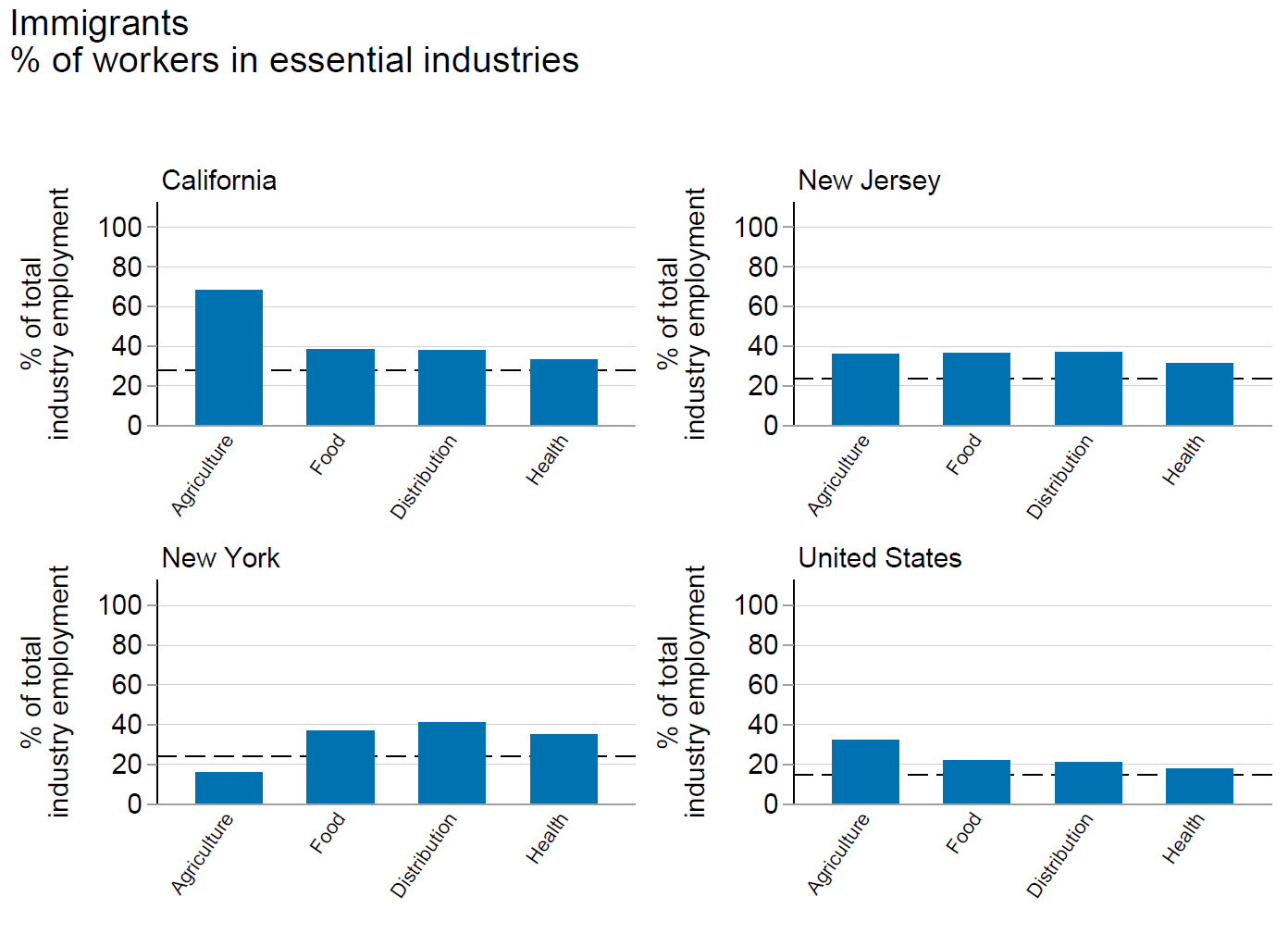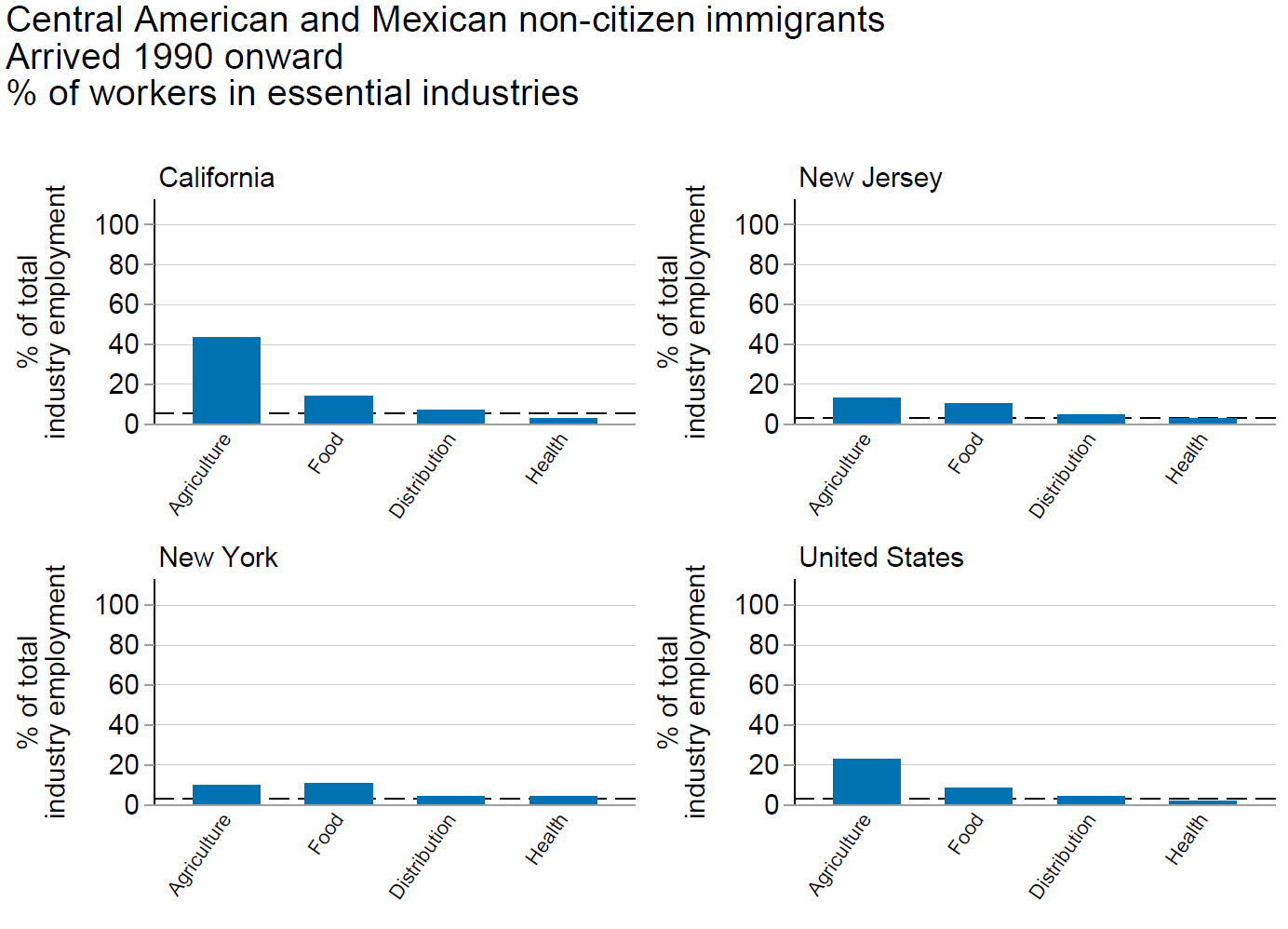Justin C. Wiltshire
- Postdoctoral Scholar
With states enforcing ‘social-distancing’ measures and curtailing individual mobility in order to limit the diffusion of the SARS-CoV-2/COVID-19 pandemic, local authorities have been pushed to identify those sectors and workers who are “essential” in this time of emergency. Workers in these essential sectors are permitted to continue working because they are considered vital to the functioning of society in this time of crisis. At the same time, by continuing to fulfill their duties by attending their places of work rather than sheltering in place, many of these workers are accepting an increased risk of exposure to and infection from the virus. For their willingness to accept this higher risk of contagion in order to perform duties essential to the economy and society, these workers have been the subject of very strong support from local communities. Often overlooked, and what we demonstrate in this Immigration Fact, is that immigrants (foreign-born individuals) and likely-undocumented immigrants are widely over-represented (sometimes by a factor of 2 or 3) among these “essential workers”.
Several states have published lists of “essential workers”.[1] While these lists vary across states, all of them define as “essential” those workers operating in four sectors which guarantee the very basic functions of society during a health emergency: (i) Agriculture and Farming; (ii) Food and beverage production and sales (P/S); (iii) Transportation and Warehousing (plus gasoline P/S); and (iv) Healthcare & social services (including medical-equipment & pharmaceutical P/S). We consider all workers in these sectors, and look at the proportion of immigrants (foreign-born) in their workforces using data from the 2018 American Community Survey, the most recent and comprehensive survey of the US population.[2]

In Figure 1 we show the foreign-born share of employment in each of these four essential sectors, looking individually at California (top left panel), the whole United States (bottom-right panel) and at the two US states most infected by the virus: New York (bottom-left panel) and New Jersey (top-right panel). The four bars in each chart represent the foreign-born percentage of employment in the four sector-groups described above, labelled (respectively, from left to right) as Agriculture, Food, Distribution, and Health. The dashed lines represent the population share of immigrants in each jurisdiction.
Three facts are immediately clear. First, in the US as a whole and in each of the three states considered, immigrants are over-represented among the four groups of “essential” workers, as the bars are all (except one) above the dashed line. In California, for instance, where about 28% of the adult population are foreign-born, 33% percent of Health workers, 38% percent of Food workers, and 38% percent of Distribution workers are foreign-born. Second, focusing on Health workers—many of whom are particularly essential and at-risk during this pandemic—and looking at the most affected states (New York and New Jersey), where these workers bear the most extreme risk, we see that close to one third are foreign-born. While foreign-born workers constitute only 14% of the overall population in the US, they comprise about 35% of Health workers in New York and 31% in New Jersey. Finally, focusing on Agriculture, one sees how the US national production of agricultural goods depends heavily on foreign-born workers, which represent one third of national workers, and close to 70% of California’s agricultural workers. Overall, it is indisputable that immigrants are a large and over-represented proportion of essential workers in the US.

Figure 2 shows the employment shares in California, New Jersey, New York, and the whole US, of a specific group of immigrants whose members have high probability of being undocumented: Mexican and Central American non-citizens who arrived in the US after 1989. These charts show that this group, representing on average 3% of US and 5.6% of California’s population, is usually over-represented among essential workers. In this case, the largest over-representation is in Agriculture: this group comprises 22% of Agriculture workers in the US and 43% in California. Most of the manually intensive, risky jobs in Agriculture are performed by Mexican and Central American immigrants, who are often undocumented and who have continued to keep the US Agriculture industry operating even in these months of the COVID-19 pandemic.
These simple numbers suggest that immigrants are disproportionately risking exposure to the virus to continue contributing their productive ability where it is needed-- contributions which many Americans are recognizing. The economic and social contributions of immigrants during this period of crisis are particularly evident. Moreover, because workers in these sectors are at greater risk of exposure to the virus, immigrants will end up bearing a higher share of the cost of this pandemic, in terms of infections and deaths.
This should be a time when immigration policy supports and helps these workers. One possibility would be to allow those immigrants who are working in particularly needed and exposed fields—e.g. foreign healthcare workers—to obtain visas and permanent residence more easily. Another would be to allow foreign doctors to practice in the US with fewer administrative hurdles[3]. Instead, on April 22nd, 2020, President Trump signed an executive order halting for two months the issuance of green cards to people immigrating from abroad. While de facto immigration is already suspended and while the ban excludes people already in the US and immediate family, the message that it sends is counterproductive. Rather than helping hard working, risk-taking immigrants (doctors, food sector workers, nurses) who are saving American lives and producing and distributing needed American food, this action casts immigrants as a threat and complicates the road to a working permit for their family members.
[1] E.g. California (https://covid19.ca.gov/img/EssentialCriticalInfrastructureWorkers.pdf), New York (https://www.mynbc5.com/article/who-qualifies-as-an-essential-worker-in-new-york-state/31824555)
[2] Data downloaded from IPUMS USA: Steven Ruggles, Sarah Flood, Ronald Goeken, Josiah Grover, Erin Meyer, Jose Pacas and Matthew Sobek. IPUMS USA: Version 10.0 [dataset]. Minneapolis, MN: IPUMS, 2020.
[3] See the obstacles foreign physicians are facing in this article (https://www.cnn.com/2020/03/30/us/immigrant-medical-professionals-sidelined/index.html)